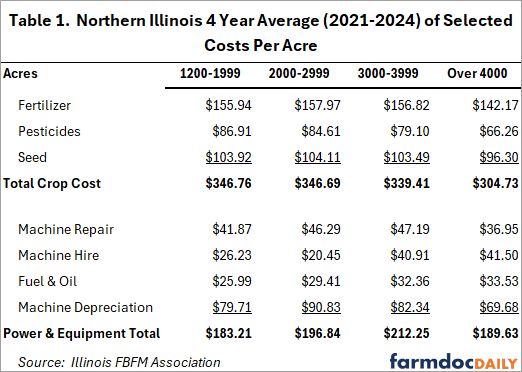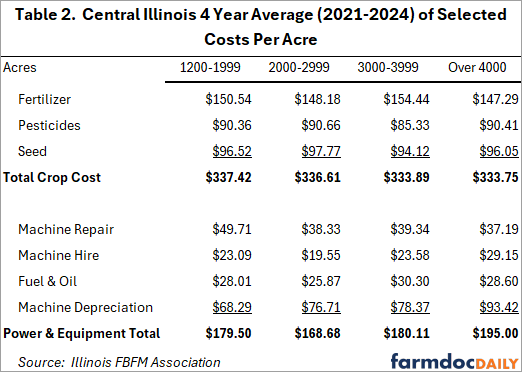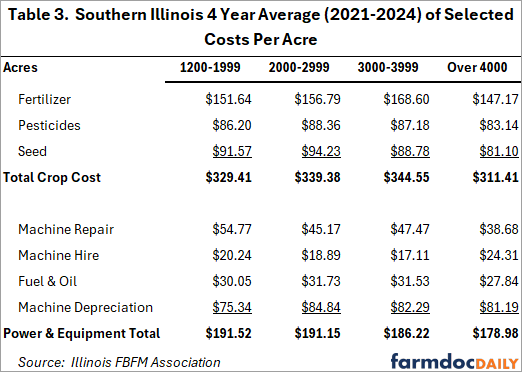How Farm Size Affects Crop and Equipment Costs in Illinois?
The notion that larger farms operate with a different—and often lower—cost structure is a common viewpoint. It seems logical that more acres allow for spreading fixed costs and that purchasing in larger quantities can lead to discounts. This would indicate that as farms increase in size that costs are lower. With that in mind, let’s review some costs looking at Illinois Farm Business Farm Management (FBFM) data from four groups of farms and draw our own conclusions. The data is a four-year average from 2021 through 2024. The costs used from the FBFM data set are on an accrual basis. We will look at selected per acre costs on increasing average farm size (in acres) for farms in northern Illinois, central Illinois, and southern Illinois.
Crop Costs
For the four-year average, total crop costs in central Illinois show little variance as farm size increases. Northern Illinois shows declining crop costs as farm size increases, while Southern Illinois experiences rising crop costs up to the 4,000-acre mark, after which costs begin to decrease. Crop costs from Illinois FBFM data include fertilizer, pesticides and seed. A closer look at each of the components of crop costs reveals some differences in cost per acre as farm size increases. Northern Illinois does show lower crop costs as farm size increases over 4,000 acres but not much variance before that acre size. Central Illinois shows the same trend for fertilizer and pesticides, but little variance in the cost for seed as farm size increases. Fertilizer costs increase as acreage grows to 4,000 acres, while pesticide and seed costs show little variation, but all 3 crop costs decrease for the 4,000 acres and above group in southern Illinois.
Power and Equipment Costs
Power and equipment costs include utilities, machinery repairs, machinery hire, fuel & oil, light vehicle expense and machinery depreciation. Illinois FBFM uses the concept of economic depreciation to more accurately assess depreciation cost than tax depreciation. Northern Illinois farms show an increasing cost per acre for machine hire and fuel & oil but a decreasing cost per acre from the 3,000 to 3,999 acres group to the over 4,000 acres group for machinery repairs and depreciation. Central Illinois farms show an increase in machine hire and depreciation costs as farm size increases. Machine repairs and fuel & oil costs are similar over the various groups for the four-year average in central Illinois. Southern Illinois shows that machinery repairs decrease as acres increase. For the other power and equipment costs in southern Illinois, the 2,000-2,999 and 3,000-3,000 acre groups are similar, but for the 4,000 acres and over group machine hire cost increase while decreasing slightly for fuel & oil and machinery costs.
Summary
A review of selected four-year average costs by farm size reveals that larger farms do not always experience lower costs per acre. While certain efficiencies are evident—especially in fertilizer and pesticide expenses for large farms in northern Illinois—other costs, such as machine hire or depreciation, may rise with size.
The data also show significant regional variation, reinforcing the importance of benchmarking within your geographic context.
Ultimately, farm operators should analyze their own operation’s records and trends over time. Doing so will help identify the most effective strategies for cost control and achieving long-term profitability. The author would like to acknowledge that data used in this study comes from farms across the State of Illinois enrolled in Illinois Farm Business Farm Management (FBFM) Association. Without their cooperation, information as comprehensive and accurate as this would not be available for educational purposes. FBFM, which consists of 5,000 plus farmers and 68 professional field staff, is a not-for-profit organization available to all farm operators in Illinois. FBFM field staff provide on-farm counsel with computerized recordkeeping, farm financial management, business entity planning and income tax management. For more information, please contact the State Headquarters located at the University of Illinois Department of Agricultural and Consumer Economics at 217-333-8346 or visit the FBFM website at www.fbfm.org.
Disclaimer: We request all readers, electronic media and others follow our citation guidelines when re-posting articles from farmdoc daily. Guidelines are available here. The farmdoc daily website falls under University of Illinois copyright and intellectual property rights. For a detailed statement, please see the University of Illinois Copyright Information and Policies here.










